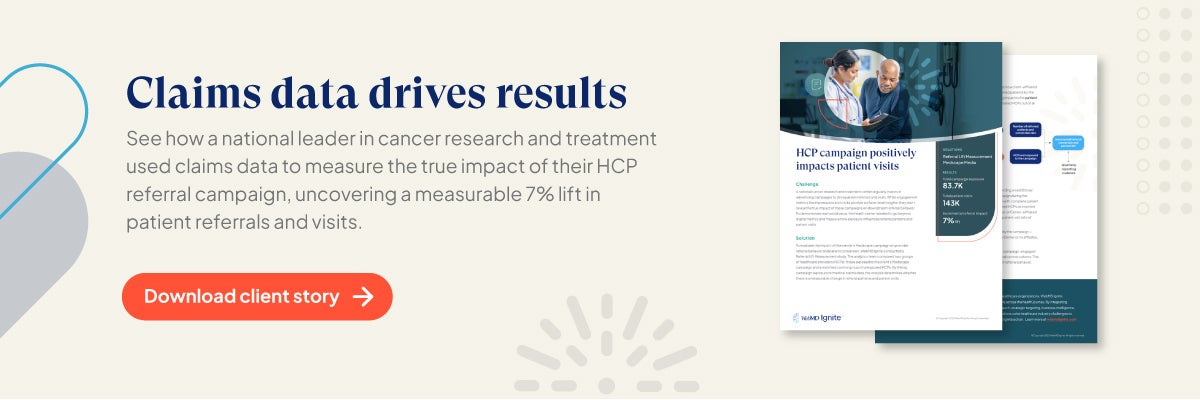Impressions to impact: How healthcare marketers prove HCP campaign value

Healthcare marketers know the pressure to demonstrate ROI. While digital metrics like clicks and impressions are easy to access, they only scratch the surface of a campaign’s true impact. The real question stakeholders are asking is: Did this campaign actually influence behavior?
Marketing to healthcare providers (HCPs) to drive referrals is a strategic imperative in today’s competitive healthcare landscape. Effective initiatives build trust, establish credibility, and foster strong relationships — positioning organizations as leaders in their fields. By embracing targeted strategies, healthcare organizations can boost visibility, communicate unique value propositions, and cultivate a robust referral network that drives sustained growth.
And let’s face it: We’re working in a landscape where relationships and real-world influence matter more than ever. That means marketers need to move beyond awareness tactics and focus on proving real, measurable downstream impact.
That’s why more and more healthcare organizations are turning to referral lift measurement studies — a method that uses claims data to compare behaviors between HCP audiences who were exposed to a campaign and those who weren’t. This approach helps bridge the gap between marketing activity and tangible outcomes like patient visits and referrals.
Why this matters now
In today’s value-driven healthcare environment, marketing teams have to align closely with clinical and operational goals. Proving that a campaign led to more specialty visits, increased screenings, or improved care navigation is no longer a “nice to have” — it’s a must have. Being able to show that your campaign not only reached the right providers, but actually moved them to act, can make all the difference when it comes to future budgets and strategy decisions.
Demonstrating lift in real-world behaviors — whether that’s more referrals, better patient engagement, or increased conversions — gives marketing teams a seat at the strategy table (where you most definitely want to be) and shows how your work supports bigger organizational goals.
How to get started
To prove campaign impact, healthcare marketers should:
1: Work with partners who can integrate marketing exposure data with de-identified claims
Bridging the gap between media exposure and clinical outcomes takes access to both types of data — and the ability to link them responsibly. Look for a partner who knows HIPAA compliance, de-identification best practices, and how to securely connect audience-level ad exposure to claims activity without compromising privacy. It also helps if they speak the language of healthcare. A partner with clinical fluency can help translate your findings into insights that actually move the needle for both provider outreach and patient engagement.
2: Design target and matched control groups to ensure valid comparisons
Start by identifying your target providers — those exposed to your campaign. You’ll need their NPIs, matched to campaign tactics (via deliverable IDs), and documented exposure dates.
Next, build a control group. These are similar providers who didn’t see your campaign. Each target is matched one-to-one with a control based on specialty, location, and/or affiliation with your health system. To make the data valid, all providers — both target and control — should be active and submitting claims within the past 18 months.
Referral activity is tracked across both groups, using the target provider’s campaign exposure date as the anchor. This setup lets you clearly isolate and attribute behavioral differences to your campaign. Having a rigorous methodology helps rule out other factors and elevates the credibility of your results when sharing across internal teams or with leadership.
3: Define success metrics early
Before the campaign launches, get alignment on what success looks like. Are you trying to increase specialist referrals? Drive more wellness visits? Boost engagement with a particular service line? Defining KPIs upfront ensures your study will focus on what matters most to the organization — that way results are tied to what actually matters for your stakeholders.
4: Communicate findings in both clinical and marketing terms
Your results should resonate across departments. Translate the data into language that speaks to marketing teams (lift, engagement, ROI) and clinical leaders (volume increases, patient pathways, intervention timing). When you can do both, you’re not just reporting numbers — you’re positioning yourself as an invaluable strategic partner.
Final thought
Campaigns should drive more than awareness. They should drive action. With the right approach, you can prove they do. Referral lift studies don’t just demonstrate impact. They also turn marketing into a strategic growth engine, delivering the evidence organizations need to execute smarter, data-backed investments (and make you look pretty great while doing it).





